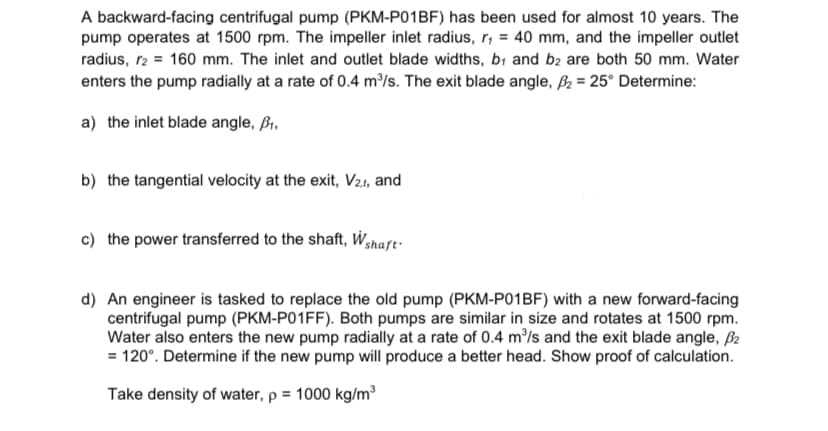A backward-facing centrifugal pump (PKM-P01BF) has be pump operates at 1500 rpm. The impeller inlet radius, r₁ radius, r2 = 160 mm. The inlet and outlet blade widths, enters the pump radially at a rate of 0.4 m³/s. The exit blad a) the inlet blade angle, B₁, b) the tangential velocity at the exit, V2.1, and
A backward-facing centrifugal pump (PKM-P01BF) has be pump operates at 1500 rpm. The impeller inlet radius, r₁ radius, r2 = 160 mm. The inlet and outlet blade widths, enters the pump radially at a rate of 0.4 m³/s. The exit blad a) the inlet blade angle, B₁, b) the tangential velocity at the exit, V2.1, and
Elements Of Electromagnetics
7th Edition
ISBN:9780190698614
Author:Sadiku, Matthew N. O.
Publisher:Sadiku, Matthew N. O.
ChapterMA: Math Assessment
Section: Chapter Questions
Problem 1.1MA
Related questions
Question
fluid
please help ne solve this in details!

Transcribed Image Text:A backward-facing centrifugal pump (PKM-P01BF) has been used for almost 10 years. The
pump operates at 1500 rpm. The impeller inlet radius, r₁ = 40 mm, and the impeller outlet
radius, r2 = 160 mm. The inlet and outlet blade widths, b₁ and b2 are both 50 mm. Water
enters the pump radially at a rate of 0.4 m³/s. The exit blade angle, ₂= 25° Determine:
a) the inlet blade angle, ₁.
b) the tangential velocity at the exit, V2.1, and
c) the power transferred to the shaft, Wshaft.
d) An engineer is tasked to replace the old pump (PKM-P01BF) with a new forward-facing
centrifugal pump (PKM-P01FF). Both pumps are similar in size and rotates at 1500 rpm.
Water also enters the new pump radially at a rate of 0.4 m³/s and the exit blade angle, 2
= 120°. Determine if the new pump will produce a better head. Show proof of calculation.
Take density of water, p = 1000 kg/m³
Expert Solution
This question has been solved!
Explore an expertly crafted, step-by-step solution for a thorough understanding of key concepts.
Step by step
Solved in 4 steps with 4 images

Knowledge Booster
Learn more about
Need a deep-dive on the concept behind this application? Look no further. Learn more about this topic, mechanical-engineering and related others by exploring similar questions and additional content below.Recommended textbooks for you

Elements Of Electromagnetics
Mechanical Engineering
ISBN:
9780190698614
Author:
Sadiku, Matthew N. O.
Publisher:
Oxford University Press

Mechanics of Materials (10th Edition)
Mechanical Engineering
ISBN:
9780134319650
Author:
Russell C. Hibbeler
Publisher:
PEARSON

Thermodynamics: An Engineering Approach
Mechanical Engineering
ISBN:
9781259822674
Author:
Yunus A. Cengel Dr., Michael A. Boles
Publisher:
McGraw-Hill Education

Elements Of Electromagnetics
Mechanical Engineering
ISBN:
9780190698614
Author:
Sadiku, Matthew N. O.
Publisher:
Oxford University Press

Mechanics of Materials (10th Edition)
Mechanical Engineering
ISBN:
9780134319650
Author:
Russell C. Hibbeler
Publisher:
PEARSON

Thermodynamics: An Engineering Approach
Mechanical Engineering
ISBN:
9781259822674
Author:
Yunus A. Cengel Dr., Michael A. Boles
Publisher:
McGraw-Hill Education

Control Systems Engineering
Mechanical Engineering
ISBN:
9781118170519
Author:
Norman S. Nise
Publisher:
WILEY

Mechanics of Materials (MindTap Course List)
Mechanical Engineering
ISBN:
9781337093347
Author:
Barry J. Goodno, James M. Gere
Publisher:
Cengage Learning

Engineering Mechanics: Statics
Mechanical Engineering
ISBN:
9781118807330
Author:
James L. Meriam, L. G. Kraige, J. N. Bolton
Publisher:
WILEY